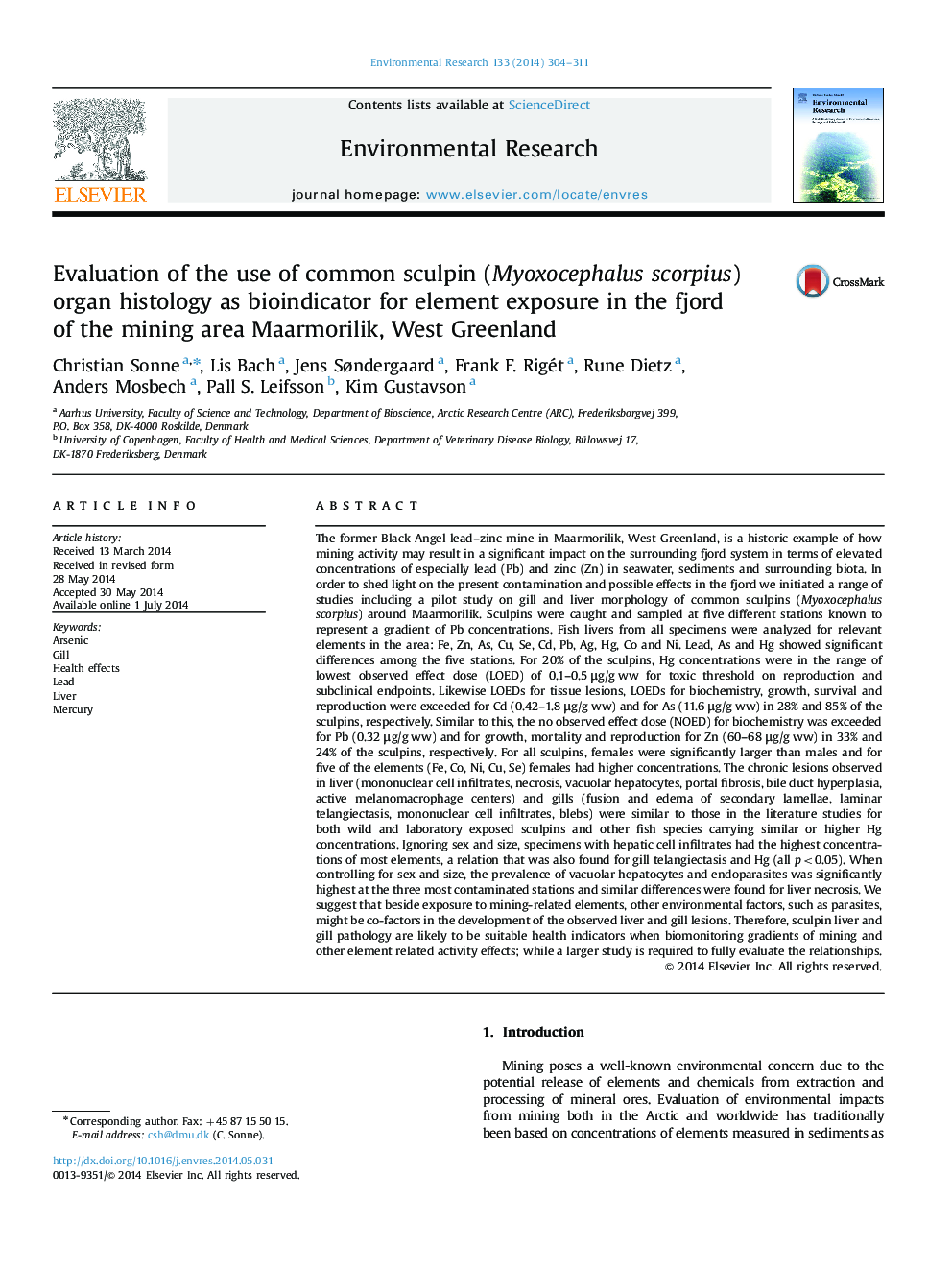| کد مقاله | کد نشریه | سال انتشار | مقاله انگلیسی | نسخه تمام متن |
|---|---|---|---|---|
| 4469742 | 1622568 | 2014 | 8 صفحه PDF | دانلود رایگان |

• Black Angel Pb–Zn mine in West Greenland has led to significant metal pollution.
• Gill and liver morphology of common sculpins was evaluated as bioindicators.
• Significant pathologies were found and were related to metal concentrations.
• Sculpin pathology may be suitable health indicators for mining activity effects.
• These should be enrolled in EIAs of raw material industrialization in the Arctic.
The former Black Angel lead–zinc mine in Maarmorilik, West Greenland, is a historic example of how mining activity may result in a significant impact on the surrounding fjord system in terms of elevated concentrations of especially lead (Pb) and zinc (Zn) in seawater, sediments and surrounding biota. In order to shed light on the present contamination and possible effects in the fjord we initiated a range of studies including a pilot study on gill and liver morphology of common sculpins (Myoxocephalus scorpius) around Maarmorilik. Sculpins were caught and sampled at five different stations known to represent a gradient of Pb concentrations. Fish livers from all specimens were analyzed for relevant elements in the area: Fe, Zn, As, Cu, Se, Cd, Pb, Ag, Hg, Co and Ni. Lead, As and Hg showed significant differences among the five stations. For 20% of the sculpins, Hg concentrations were in the range of lowest observed effect dose (LOED) of 0.1–0.5 μg/g ww for toxic threshold on reproduction and subclinical endpoints. Likewise LOEDs for tissue lesions, LOEDs for biochemistry, growth, survival and reproduction were exceeded for Cd (0.42–1.8 μg/g ww) and for As (11.6 μg/g ww) in 28% and 85% of the sculpins, respectively. Similar to this, the no observed effect dose (NOED) for biochemistry was exceeded for Pb (0.32 μg/g ww) and for growth, mortality and reproduction for Zn (60–68 μg/g ww) in 33% and 24% of the sculpins, respectively. For all sculpins, females were significantly larger than males and for five of the elements (Fe, Co, Ni, Cu, Se) females had higher concentrations. The chronic lesions observed in liver (mononuclear cell infiltrates, necrosis, vacuolar hepatocytes, portal fibrosis, bile duct hyperplasia, active melanomacrophage centers) and gills (fusion and edema of secondary lamellae, laminar telangiectasis, mononuclear cell infiltrates, blebs) were similar to those in the literature studies for both wild and laboratory exposed sculpins and other fish species carrying similar or higher Hg concentrations. Ignoring sex and size, specimens with hepatic cell infiltrates had the highest concentrations of most elements, a relation that was also found for gill telangiectasis and Hg (all p<0.05). When controlling for sex and size, the prevalence of vacuolar hepatocytes and endoparasites was significantly highest at the three most contaminated stations and similar differences were found for liver necrosis. We suggest that beside exposure to mining-related elements, other environmental factors, such as parasites, might be co-factors in the development of the observed liver and gill lesions. Therefore, sculpin liver and gill pathology are likely to be suitable health indicators when biomonitoring gradients of mining and other element related activity effects; while a larger study is required to fully evaluate the relationships.
Journal: Environmental Research - Volume 133, August 2014, Pages 304–311